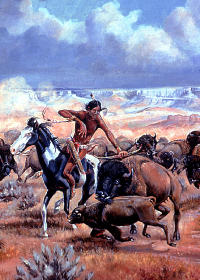
Kiowa Buffalo Hunt by Otho Stubbs.
Courtesy of Otho Stubbs.
Click images to enlarge
|
|
The disappearance of the buffalo impoverished the
tribes and forced them to depend on reservation rations…
. Among the Indians there was talk of war and killing,
and of driving the white man from the land.
|
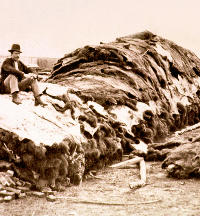
A stack of buffalo hides at a Dodge
City hide yard. Commercial buffalo hunters slaughtered
the animals by the thousands and left their carcasses
to rot on the Plains. Photo courtesy of the Kansas State
Historical Society.
|
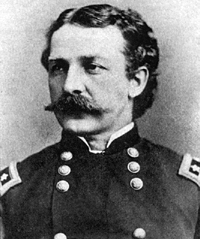
Col. Nelson A. Miles was the commander
of one of the army columns in the first battle of the
Red River campaign.
|
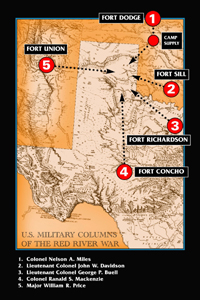
U.S. Army columns of the Red River
War. Courtesy of the Texas Historical Commission.
|
|
The Red River War of 1874
During the summer of 1874,
the U. S. Army launched a campaign to remove the Comanche,
Kiowa, Southern Cheyenne, and Arapaho Indian tribes from the
Southern Plains and enforce their relocation to reservations
in Indian Territory. The actions of 1874 were unlike any prior
attempts by the Army to pacify this area of the western frontier.
The Red River War led to the end of an entire way of life
for the Southern Plains tribes and brought about a new chapter
in Texas history.
A number of factors led to the military's campaign
against the Indians. Westward-bound settlers came into conflict
with the nomadic tribes that claimed the buffalo plains as
their homeland during the nineteenth century. To provide a
measure of protection for these settlers, the Army established
a series of frontier forts. The outbreak of the Civil War
resulted in a withdrawal of the military from the western
frontier. The Indians took advantage of the situation and
aggressively exerted control over the Southern Plains. There
was an outcry for the government to take action.
The Medicine Lodge Treaty of 1867 called for
two reservations to be set aside in Indian Territory—one
for the Comanche and Kiowa and another for the Southern Cheyenne
and Arapaho. According to the treaty, the government would
provide the tribes with a variety of basic services and training,
housing, food and supplies, including guns and ammunition
for hunting. The goods would be allotted to the tribes each
year for a thirty-year period and the Indian tribes would
be allowed to continue to "hunt on any lands south
of the Arkansas River so long as the buffalo may range thereon."
In exchange, the Indians agreed to stop their attacks and
raids. Ten chiefs endorsed the treaty and many tribal members
moved voluntarily to the reservations.
But the treaty was destined for failure. Commercial
buffalo hunters essentially ignored the terms of the treaty
as they moved into the area promised to the Southern Plains
Indians. The great southern herd of American bison, lifeblood
of the Southern Plains tribes, was all but exterminated in
just four years—from 1874 to 1878. The hunters slaughtered
the animals by the thousands, sending the hides back East
and leaving the carcasses to rot on the plains—and the
U.S. government did nothing to stop them. The disappearance
of the buffalo impoverished the tribes and forced them to
depend on reservation rations.
The promises made by the U.S. government proved
largely empty. Food was inadequate and of poor quality, while
reservation restrictions were all but impossible for the Indians,
who were used to roaming over the plains at will, to understand
or accept. By late spring of 1874, discontent lay heavy on
the reservations. As conditions continued to worsen many of
the Indians who were still there now left to join with the
renegade bands who had returned to the Texas plains. Among
the Indians there was talk of war and killing, and of driving
the white man from the land.
During the spring of 1874 a leader and prophet
for the Indians emerged in the person of Isa-tai of the Quahadi
Band of Comanches. Isa-tai's medicine was viewed as being
very strong and he was doing his best to incite a war against
the whites. Because the majority of Indians now saw themselves
as being in a desperate situation with the only alternative
to starvation being war, it took little persuasion by Isa-tai
to convince the Indian leaders they must strike back at the
whites. Thus, a plan was formed that the Indians would attack
and destroy the new settlement of buffalo hunters at Adobe
Walls.
In the early-morning hours of June 27, 1874
some 300 Indians, led by Isa-tai and famed Comanche chief
Quanah Parker, attacked the Adobe Walls post. The Indians
planned to catch the whites by surprise and simply overpower
them. Although the 28 hunters who occupied the post were vastly
outnumbered, they were well armed with long-range rifles and
were able to hold off the Indians. With their failure at Adobe
Walls, many of the Indians began to spread out over the plains
of Texas for one final grasp at the old ways of life. The
increasing realization that their access to ancestral lands
was diminishing encouraged many of the Indians to strike at
the encroaching whites. The realization that the buffalo,
their main source for survival, was quickly disappearing forced
them to fight. For the Indians, this brought retaliation by
the U.S. Army, defeat, and confinement to the hated reservations.
 Model 1873 Springfield .45-70 carbine,
the weapon adopted by the U.S. Army for cavalry use on the
Plains.
The attack on Adobe Walls by the Indians served
as a catalyst for the U.S. Army to make plans to subdue the
Southern Plains tribes once and for all. The new policy called
for enrollment and protection of innocent and friendly Indians
at their reservations, and pursuit and destruction of hostile
Indians without regard for reservation or departmental boundaries.
The primary objective of the military campaign of 1874 was
the removal of the Indian groups from this area of Texas and
the opening of the region to Anglo-American settlement. General
Philip Sheridan later characterized the military operations
as "not only comprehensive, but…the most successful
of any Indian Campaign in this country since its settlement
by the whites."
The offensive utilized five columns converging
on the general area of the Texas Panhandle and specifically
upon the upper tributaries of the Red River where the Indians
were believed to be. The strategy aimed at full encirclement
of the region, thereby eliminating virtually all gaps through
which the Indians might escape. Colonel Nelson A. Miles moved
southward from Fort Dodge; Lieutenant Colonel John W. Davidson
marched westward from Fort Sill; Lieutenant Colonel George
P. Buell moved northwest from Fort Griffin; Colonel Ranald
S. Mackenzie came northward from Fort Concho; and Major William
R. Price marched eastward across the Panhandle from Fort Union.
The plan called for the converging columns to maintain a continuous
offensive until a decisive defeat had been inflicted on the
Indians.
During the Red River War of 1874, as many
as 20 engagements between the U.S. Army and the Southern Plains
Indians may have taken place across the Texas Panhandle region.
The well-equipped Army kept the Indians on the run until eventually
they could not run or fight any longer. The Red River War
officially ended in June 1875 when Quanah Parker and his band
of Quahadi Comanche entered Fort Sill and surrendered. The
Indians were defeated and would never again freely roam the
buffalo plains.
|
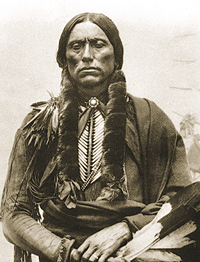
Comanche Chief Quanah Parker. With
Indian prophet Isa-tai, he led some 300 Indians in an
attack on buffalo hunters in the Adobe Walls post.
|
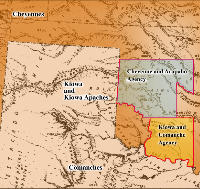
Southern Plains Indian tribes during
the Red River War and location of reservations. Map
courtesy of the Texas Historical Commission.
|
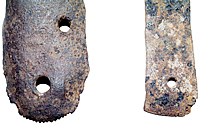
Metal fleshers made by the Indians and used to scrape
hides. Photo courtesy of the Texas Historical Commisssion.
|
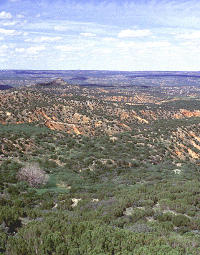
U.S. Army soldiers and Indian warriors
engaged in running battles through rugged terrain such
as this near Palo Duro Canyon during the Red River War.
Photo courtesy of the Texas Historical Commission.
|
|
The well-equipped Army kept the Indians on the run
until eventually they could not run or fight any longer…
. The Indians were defeated and would never again freely
roam the buffalo plains.
|
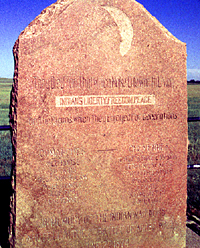
Monument at the Adobe Walls battle
site dedicated to the Indians who were killed at the
battle. Photo courtesy of the Texas Historical Commission.
|
|